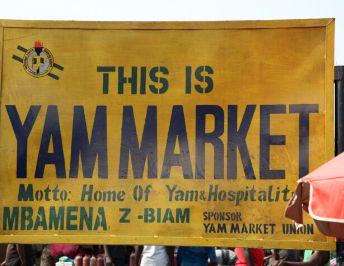Nigeria is by far the world’s largest producer of yams, accounting for over 70 –76 percent of the world production. According to the Food and Agriculture Organization report, in 1985, Nigeria produced 18.3 million tonnes of yam from 1.5 million hectares, representing 73.8 percent of total yam production in Africa. According to the 2008 figures, yam production in Nigeria has nearly doubled since 1985, with Nigeria producing 35.017 million metric tonnes with value equivalent of US$5.654 billion. In perspective, the world’s second and third largest producers of yams, Côte d’Ivoire and Ghana, only produced 6.9 and 4.8 million tonnes of yams in 2008 respectively. According to the International Institute of Tropical Agriculture, Nigeria accounted for about 70 percent of the world production amounting to 17 million tonnes from land area 2,837,000 hectares under yam cultivation.
According to the Food and Agricultural Organization from the Global Yams Market Report 2020-2025, worldwide yam production accounted for 72,580 tonnes, and countries like Nigeria and Ghana of the African region holds a significant share in the production as the yam cultivation started 11,000 years ago and is one of the primary commodity in the region. Nigeria is accountable for over 65% of yams produced globally making it the world’s largest contributor.
So, where is the hub responsible for these figures?
Zaki Biam Yam Market, Makurdi, Benue State, Nigeria.
The experiencing naija team brings to you the largest yam market in West Africa called the Zaki-biam yam market in Ukum local government area of Benue state, Nigeria. The presence of the largest yam market in the state has also brought the state to limelight where many people from different regions of the world come to patronize the market. Among the multi-dimensional use of yam from cultural festivals, rituals to marriage rights, yam tubers are significantly used in other different ways.
Yams are starchy Staples in the form of large tubers produced by annual and perennial vines. Unpeeled yam has vitamin C. Yam, sweet in flavour, is consumed as boiled yam or fried in oil. It is also pounded into a thick paste, pounded yam, after boiling and is consumed with soup. Its use as an industrial starch has also been established as the quality of some of the species is able to provide as much starch as in cereals.
The Zaki Biam market, believed to be the largest yam market in Nigeria and perhaps Africa, accounts for 70 per cent of yam cultivated in Nigeria. The market holds every day except Sundays, but Tuesdays and Wednesdays are the busiest. Even buyers from other African countries patronize the market. The storage facility located at Zaki Biam is reported to have the capacity to store up 200,000 tubers of yam. Whether for subsistence or commercial purposes, every household in Benue State is expected to own a yam farm.
The public relations officer, (Mr. Felix Loorkyaa) of the Yam shed owners and Yam sellers of the Zaki Biam market shared with Experiencing Naija team that about 200 Lorries of yam leave the market for the east and north daily. Also, a discussion with the director of special duties and a shed owner at Zaki Biam yam market reveals the in and out of the yam business where he stated that at least in a day he sells about two to three thousand tubers of yam daily. He also mentioned that the prices vary based on the sizes of the yam with the medium size yam being around 70 naira per one tuber. He intimated us with several names of the yam based on the sizes and also the species.
One of the major challenges faced with yam farmers is the manual labour intensive process involved in yam cultivation. The use of traditional storage facilities like thatched hut to store yams is common among the farmers but this method fail to preserve yam from one harvesting season to another leading to a loss resulting from pest and decay.
Credit: Experiencing Naija Team





zubKxCPHhXMw
AQRdDoiEqBLgWZ
Thanks for the complete information
Please I want to discuss with Mr Felix Loorkyaa, the PRO about the prospect of getting Yam regularly from Zaki Biam. Can you please forward your phone no to me or get in touch with me on 08062756753.
Rev Oloyede, Aduralere farms, Ibadan